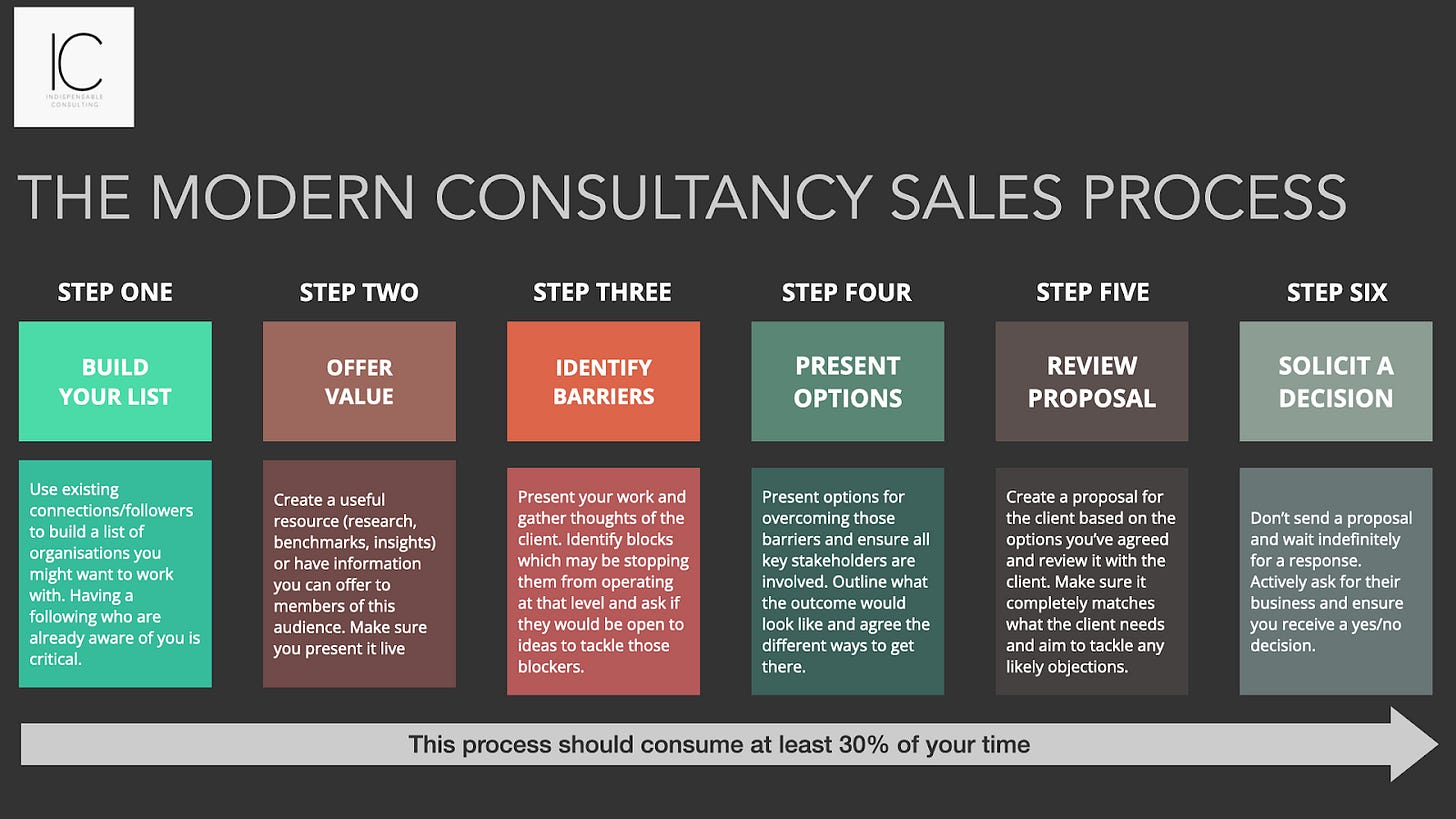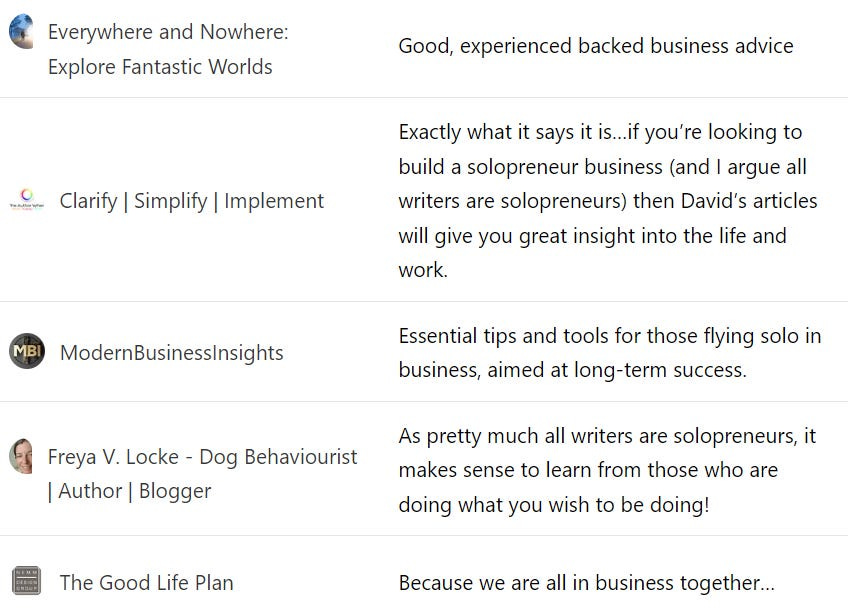Attracting Your First Clients: Creating Services, Generating Demand, Selling With Integrity
The Challenge Facing All New Consultants
The Solopreneur Stack helps solo-business people become (and remain) successful and sustainable through quick tips, in-depth guidance and personal experience stories. Become a paid subscriber for just £8 a month and unlock every article and resource in our archive.
By
I’ve spoken with dozens of people over the past few years who have been laid off by tech companies and decided to give consulting a go. Too few have been able to build a successful consulting practice.
Most newbie consultants I’ve spoken with have a mindset like this:
I’ve got [15] years of experience in my industry, I know a lot of organisations in my sector will benefit from my advice. I’ll set myself up as a consultant and promote myself on social media to build my client base.
If the market had an omniscient voice, it would be telling consultants:
You’re entering a market where existing consultants have a huge head start on you. They have a vast audience, know how to sell to clients, have refined, proven methodologies, and have dozens of case studies and testimonials they can point to. Alas, everyone has [xx] years of experience, and the clients you want to attract probably aren’t finding consultants on social media.
This is the challenge all new business consultants need to overcome. How do you enter an existing market and build a practice when the odds are stacked against you?
Trust me, I know how difficult it is. I launched my consulting practice, FeverBee, in 2008. I was a young, dumb kid with no contacts or industry expertise. Yet, despite that, I’ve since generated $6m+ in revenue, worked with many of the world’s top brands, and become recognised as a thought leader in my industry.
In this post, I will share the practical steps you can take to attract your first few clients.
If you want more information, please check out my newsletter.
Ad | Make Your First $1,000 From Your One-Person Business
This 5-day email course is perfect for beginners. No fluff, just results.
⭐ Stop procrastinating and getting distracted by shiny object syndrome.
⭐ Enjoy a straightforward, easy-to-follow email course designed to guide you step-by-step, making learning and implementation seamless and effective.
⭐ Gain valuable, real-world tips from a successful entrepreneur, equipping you with proven strategies to navigate challenges and build that biz you've always wanted
Are you ready to start? 👇
Interested in sponsoring The Solopreneur Stack? Just drop me a DM.
The Three Things You Need To Attract Clients
You’re not ‘becoming a consultant’; you’re starting a business.
And this means you need to:
Develop unique products.
Make customers aware of those products.
Persuade them to buy that product.
Many consultants make the fatal mistake of promoting themselves and their experience rather than the unique services they sell. But at this point, no-one cares about you (sorry!). They care what you can do for them.
1. Developing Unique Services
Your job is to become the world’s leading expert on a six to seven-figure problem within your chosen niche.
Begin with problems you are familiar with based on your experience. Then set up interviews with 25 people in your industry and dask:
How big of a problem is it for them? (cost/scale/impacts)
How are they solving that problem today?
What would they do differently if they were starting again?
What are the precise words and language they use to describe and communicate that problem?
What are the real root causes of the problem?
Have they used consultants to solve the problem before? If not, why not? If so, what did they like/not like about the consultant?
Believe me, once you’ve spoken to 25+ organisations about a single problem and understood how they solve it, you will be one of the top experts in that problem. Better yet, you’ve got a network of 25+ potential clients who might want to hire you (or refer you to others).
Once you’ve done the research, you can start designing your solution to the problem based on the best practices and insights you’ve gathered.
Try to name your unique solution to the problem so it stands out.
2. Generating Demand
Once you have your services, you need to build demand for them.
Many consultants jump onto social media and begin sharing thought leadership articles at this stage, hoping this will attract clients.
This isn’t usually successful because it’s simply not strategic. There’s no clear goal or theme, and it’s also a bit icky to be too self-promotional.
The best way to promote yourself is to highlight a truth most people are unaware of and support it with clear evidence. Your mission is to highlight the gap between where organisations are today and where they need to be in the future -- it’s your services that will help them cross that divide.
My recommendation is to run marketing campaigns.
These are time-limited campaigns where you spread a message through whichever channels make sense.
This campaign begins with a broad theme - that’s the singular message you want to get across.
This message shouldn’t be “I am [the best]”.
Your message should be “[x] is the best approach”
This ‘[x]’ should come from your research and match what you named the service. It should encapsulate the product you sell. It should contrast the approach many organisations take with your superior approach.
Most importantly, you must support it with clear evidence and case studies.
For example, in the past, my consultancy FeverBee said we take a ‘data-driven approach’ to building customer communities. That’s all good, but to make it engaging, we need to know who or what the enemy is.
But what is being data-driven opposed to exactly?
In our case it’s intuition, anecdotal evidence, and conventional wisdom. Once we know what the conflict is, we can start to zero in on the kind of content we might create.
We need content that:
Raises awareness of the problem.
Shares solutions to the problem.
Explains your services.
We can see examples of these below.
Problem awareness content might include:
A clear breakdown of the problem (this is your central thesis).
Benchmarking where individual organisations are today in moving to the new future.
A maturity index shows how quickly industries are progressing towards this future.
Analysing and compiling trends about the future.
Estimating the cost of the problem facing organisations.
Examples of best and worst practices.
Problem solution content might include:
Breakdowns of organisations that are solving the problem exceptionally well.
Playbooks of how to create and implement the solution(s).
Templates, scripts, and roadmaps for implementing the better approach.
Step-by-step roadmaps of how you would tackle the problem.
Case studies of organisations.
Information about your services
Generally, keep this to a minimum - but it should be there.
An overview of your services.
A clear breakdown of what makes you unique/special.
The approximate fees you charge (learn how to set fees).
Case studies and testimonials of organisations you’ve worked with.
The key to your strategy is that you don’t need hundreds of content articles. You simply need to create a dozen high-quality resources and keep them current. Make sure they’re deeply interlinked with one another.
People should find one of your articles and begin jumping down a rabbit hole of other articles.
Consider supporting The Solopreneur Stack!
Upgrade to our paid tier to unlock every article in the archive and gain free access to our online course. Become a Sustaining Member for a little bit extra and book a 1-to-1 coffee chat with David McIlroy.
3. Selling Your Services
Mastering the sales process is crucial to thriving as a consultant, though this doesn’t mean resorting to pushy tactics like cold calls or spammy messages.
The best way to stand out in sales is to always add value.
Make sure people want to hear from you because you know it will be useful to them. Remember this as you go through the sales process outlined below.
Step 1: Build Awareness / Build Your List.
We’ve just covered this in the ‘generating awareness’ section of your service. You should have a good-sized following of people you can engage with at this level.
Step 2: Offer Value
This is where you reach out to people on your mailing list or follow you and offer them exclusive value.
Here are some ideas:
A benchmark report you recently created shows how organisations in their field compare.
A short presentation showing the latest trends in your client’s sector.
A salary/budget survey highlighting how much different organisations pay staff.
How top organisations are structuring their teams, etc…
A best practices technology presentation.
In my experience, organisations are overwhelmed with opinionated advice, but they want to know how they compare to others and what organisations like themselves are doing.
The key here is that you’re not sending them a document they can ignore; you’re inviting them to a live 15 to 20-minute presentation.
You can invite several people to the same presentation or have an individual presentation for each.
What you’re looking for here are things that show the difference between where the organisation you're approaching is today and where they might need or want to be tomorrow.
Step Three: Identify Barriers To Change
The initial item you shared should clearly indicate the deficit between the organisation's current state and the desired state (if this doesn’t exist, your services aren’t needed).
As you present the information, ask them what’s holding them back from being at this level. This highlights the challenges they need to overcome. Once you know their challenges, you can ask:
“Would you be open to some ideas from me on how to tackle this?”
This should always be a relaxed, no-pressure question. You don’t want to harm the relationship—just offer an opportunity.
If you get a positive response, schedule an additional call to discuss options.
The need to change.
The barriers preventing change.
What might the options for overcoming this look like?
Wrap up the call with a question like:
Give me a little time to research some options that might work here. Let's schedule a call on [date] to review them. What times work for you?
You should also ask if anyone else might be interested in or impacted by the project and should be on the call.
Step Four: Agree On The Best Solution.
This is where you collaborate with the prospect to develop potential solutions to overcoming problems. In this stage, you should put together some options for working together and what it might look like.
Ideally, include examples and best practices that others can refer to. Depending on their ambition, different options target different challenges or structure them as low-budget to high-budget.
Your goal isn’t to sell a service. Your goal is to collaborate with the client to explore each option, whether any barriers prevent them from proceeding with one of these options, and which options are likely to be most effective.
You can adjust and tweak the options based on their feedback to ensure you arrive at something that closely matches the client's needs.
By this point, you should have a client who has agreed:
That they need to change how they’re doing something.
What that change would look like.
The best way you can support them in that change is by
At the end of this call, you should ask if they’re open to receiving a proposal on the agreed option.
Step Five: Proposal Review
You need to review the draft proposal with your prospect before creating the final proposal.
A significant part of the sales process is turning prospective clients into allies on the journey. If you’ve made it this far, interest is usually relatively high. The next step is to review the draft proposal with the client to make sure it 100% aligns with their needs.
I can’t stress enough how important it is. It can increase your odds of winning a project from 50% to 90%.
Nothing is better than a client previewing a proposal and highlighting which elements are and aren’t suited to them.
At this stage, it’s imperative to make clear that your proposal is just a draft, and you’ll collaborate on it to make it 100% correct.
It’s crucial on this call to smoke out any hesitancy or concern they might have so it can be addressed. A good question here might be:
“Before we end the call, I just want to check if you have any concerns about working with us or this project? Even if there is anything minor. We want to have great, honest relationships with clients, so if you have any minor concerns or questions, I would be keen to hear them and see if we can address them.”
This simply ensures you can tackle any issues which might trip up the process.
Step Six: Get A Decision
A common mistake is to send a proposal and then wait indefinitely for a response. That leads to a situation where you might never get a response.
Don’t do any silly closing tricks here. They just make you seem like a snake oil salesperson. Instead, you can simply ask on the call:
It sounds like we’re aligned on the project and we’ve addressed any concerns. Can I get a contract to you so we can get started?
---
If you do these steps well, you should quickly be able to build a solid foundation to attract not only your first few clients - but future clients, too.
Thank you!
Please subscribe to my newsletter to discover systems for scaling your consultancy practice to $1m+ in revenue.
[outtake]
Try Unique Tactics
A final aside…too many people copy the tactics they see others using without understanding that it’s not about the tactics—it’s about the unique skills and perspective. You need these in place first.
Once you have this, you can use plenty of tactics to build an audience. The most common, sadly, is to publish blog posts. The problem with publishing blog posts is there isn’t exactly a shortage of blog posts. There’s an endless river of blog posts gushing past us every hour (forgive the irony).
There’s also a law of diminishing returns about blog posts. For example, the difference between creating 10 and 20 resources is quite significant. But does publishing your 3001st post give you much more of an edge over your 3000th post?
The easiest way to build an audience today is to pursue the tactics others don’t have the time, resources, or ability to do.
For example:
Hosting events. Reach out to people and invite them to join your upcoming events - either in person or online.
Building direct relationships. Connect with two to three people each day to build relationships.
Participating in the events of others. Become a speaker at events.
Host your show. Perhaps it's a podcast; perhaps it’s a live experience?
Create a definitive resource. Identify your sector's 3 to 5 critical topics and create the definitive content for it. Undertake deep research, publish the results, and update it every year. Make it the best place to learn.
Create training courses. Create training courses for particular topics. Use the videos to promote yourself and your work.
Create tools. Develop and introduce interactive tools people can use to find out more about their level of success.
Each of these takes much more work, but they also help you stand out.
You can experiment with different tactics if you like. I can’t stress enough how useful it is to depart from the beaten path here.








![Table of Contents [Start Here]](https://substackcdn.com/image/fetch/$s_!SMn8!,w_140,h_140,c_fill,f_auto,q_auto:good,fl_progressive:steep,g_auto/https%3A%2F%2Fsubstack-post-media.s3.amazonaws.com%2Fpublic%2Fimages%2F2f5756ee-f6d4-4a38-be8e-e081f296856c_1286x858.png)

